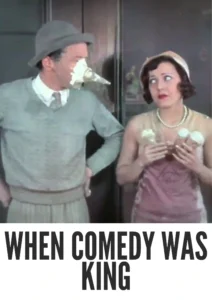Video Sources 0 Views

Download When Comedy Was King (1960) Colorized HD | Charlie Chaplin | Slapstick Extravaganza
Synopsis

Step back into the golden age of silent comedy with When Comedy Was King, a hilarious compilation film from 1960, now beautifully colorized for a viewing experience that brings these timeless gags to life like never before. This film, directed by Robert Youngson, is a tribute to some of the greatest comedic stars of the silent era, showcasing their most iconic routines and physical humor. Perfect for both classic film aficionados and newcomers eager to discover the magic of slapstick, this HD download offers a revitalized journey into a world of pure, unadulterated laughter. Alternative titles include Als Lachen Trumpf war, 滑稽大王, and Kun nauru oli valttia.
When Comedy Was King is a celebration of the silent film comedians who reigned supreme in the early days of cinema. The film strings together classic clips and routines from legendary performers, offering a fast-paced and riotous overview of the era’s comedic landscape.
Among the many highlights: Charlie Chaplin’s early work at Keystone Studios, where his iconic Tramp character was born; Buster Keaton’s incredible stunts and deadpan delivery as he’s relentlessly pursued by an entire police force; and the chaotic partnership of Laurel and Hardy, whose mutual destruction is always a sight to behold. Other featured comedians include Fatty Arbuckle, Mabel Normand, Harry Langdon, and Snub Pollard, each contributing their unique brand of physical comedy and visual gags to the mix. The film also pays tribute to the Keystone Cops, whose exaggerated antics and constant mishaps epitomized the slapstick style of the era. When Comedy Was King is a non-stop barrage of comedic brilliance, showcasing the enduring appeal of silent film’s greatest clowns.
The film is a compilation, featuring a vast array of comedic legends:
-
Charlie Chaplin
-
Buster Keaton
-
Laurel and Hardy
-
Fatty Arbuckle
-
Mabel Normand
-
Harry Langdon
-
Snub Pollard
-
The Keystone Cops
When Comedy Was King falls squarely into the genre of slapstick comedy, a style characterized by exaggerated physical humor, absurd situations, and visual gags. It is also a documentary, offering historical context and insights into the silent film era and its comedic pioneers.
Released in 1960, When Comedy Was King arrived at a time when there was renewed interest in the silent film era. Robert Youngson’s film played a crucial role in introducing a new generation to the comedic geniuses of the past. The silent era was a time of great innovation in filmmaking, and slapstick comedy was one of its defining characteristics. Without dialogue, comedians relied on their physicality, facial expressions, and creative use of props to generate laughter. When Comedy Was King captures the spirit of this era, showcasing the artistry and ingenuity of its greatest performers. The film helped pave the way for the slapstick revival of the 1960s, influencing comedies like It’s a Mad, Mad, Mad, Mad World and The Great Race.
This colorized version of When Comedy Was King has been meticulously restored, breathing new life into these classic routines for modern audiences. The colorization process involved careful attention to detail, ensuring that the colors enhance the comedic effect without detracting from the original performances. While the exact methods remain closely guarded, advanced digital techniques were used to add nuanced colors, bringing a fresh perspective to the characters and settings. The result is a vibrant and engaging viewing experience that allows viewers to appreciate these timeless comedies in a whole new way. Although the colorization of classic films can be a controversial topic, it also has the benefit of introducing these classic movies to a wider audience, guaranteeing their survival for future generations.
-
: Robert Youngson
-
: Robert Youngson
-
: Robert Youngson
-
: 20th Century Fox
-
: 81 minutes
-
: MP4
-
: HD (1080p)
-
: Compatible with most devices, including smartphones, tablets, computers, and smart TVs.
When Comedy Was King (1960) has been praised for its loving tribute to the silent film comedians and its ability to capture the essence of their humor. Many critics have noted that the film serves as an excellent introduction to the world of slapstick comedy, inspiring viewers to seek out more films from the era. While some have criticized the film’s narration and editing, most agree that When Comedy Was King is a valuable and entertaining document of a bygone era. The film helped to revitalize the careers of many of its featured performers and cemented their legacy as comedic icons.
-
: What is When Comedy Was King about?
-
A: When Comedy Was King is a compilation film showcasing the greatest comedic stars of the silent era.
-
-
: Who are some of the comedians featured in the film?
-
A: The film features Charlie Chaplin, Buster Keaton, Laurel and Hardy, Fatty Arbuckle, Mabel Normand, Harry Langdon, and Snub Pollard, among others.
-
-
: Is this version of When Comedy Was King colorized?
-
A: Yes, this version has been professionally colorized to enhance the viewing experience.
-
-
: What makes When Comedy Was King a good introduction to silent comedy?
-
A: The film offers a fast-paced and entertaining overview of the era’s comedic landscape, showcasing the best routines and physical humor of its greatest stars.
-
-
: What is the download format?
-
A: The download format is MP4, which is compatible with most devices.
-
-
: What resolution is the download?
-
A: The resolution is HD (1080p), providing a high-quality viewing experience.
-
Watch When Comedy Was King Today!










